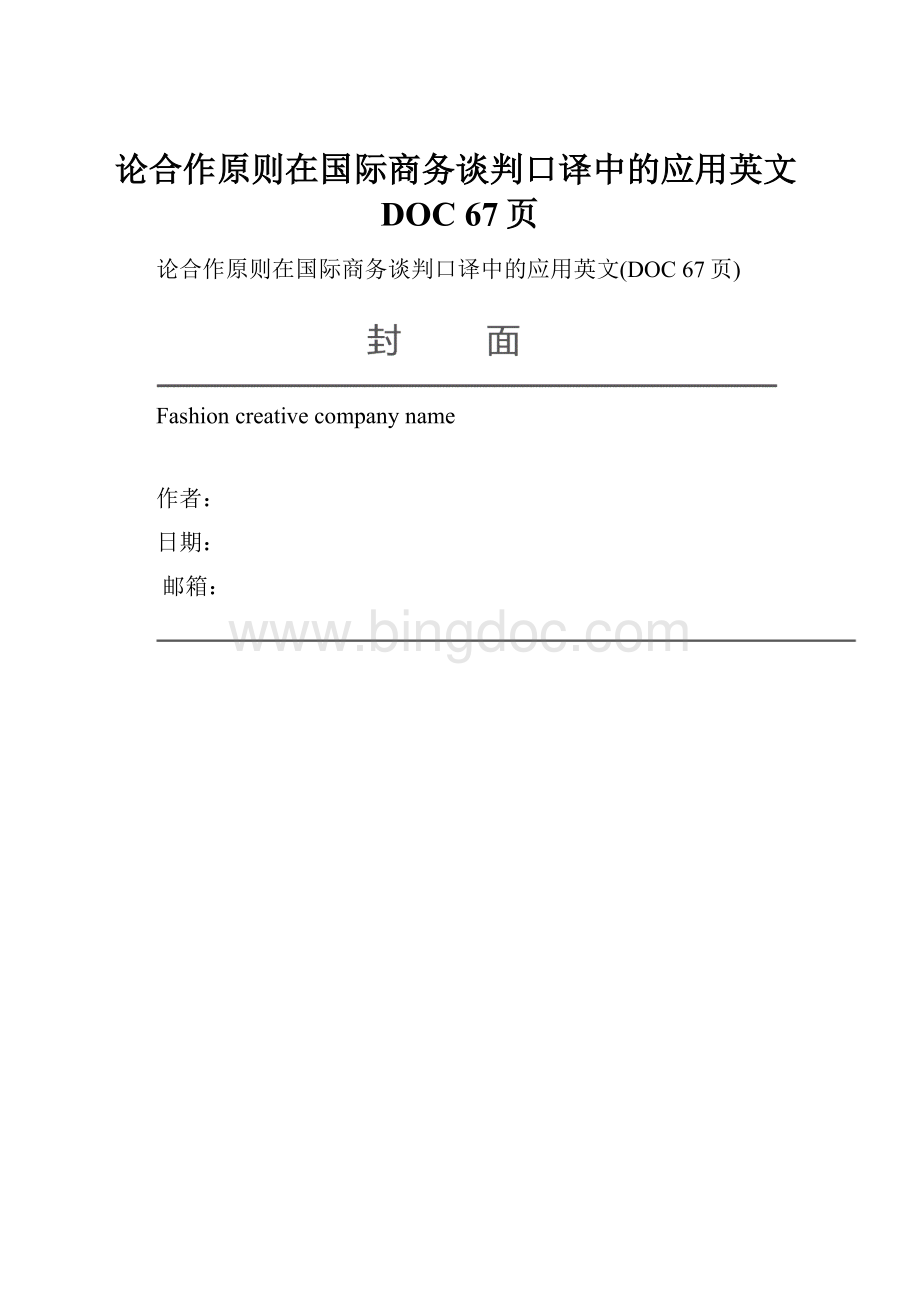论合作原则在国际商务谈判口译中的应用英文DOC 67页.docx
《论合作原则在国际商务谈判口译中的应用英文DOC 67页.docx》由会员分享,可在线阅读,更多相关《论合作原则在国际商务谈判口译中的应用英文DOC 67页.docx(146页珍藏版)》请在冰点文库上搜索。

论合作原则在国际商务谈判口译中的应用英文DOC67页
论合作原则在国际商务谈判口译中的应用英文(DOC67页)
Fashioncreativecompanyname
作者:
日期:
邮箱:
论合作原则在国际商务谈判口译中的应用
外国语言学及应用语言学专业研究生黄丽娟指导教师任文
相对而言,口译的历史要比笔译的历史久远得多。
但由于口译的工作
语言具有转瞬即逝的特点,这导致在历史上鲜有留下直观资料供大家研
究,也使得口译理论的研究远远滞后于笔译。
近几十年来,许多与口译研
究密切相关的学科,诸如语言学、心理语言学、语用学、认知心理学、神
经心理学等,对于口头交际中语言与思维的研究已经取得了相当可观的成
果。
作为沟通跨语言、跨文化交际的口译活动,借助相关学科的研究成果
进行跨学科的深入探讨势在必行。
美国语言哲学家格赖斯(H.P.Grice)于1967年在美国哈佛大学所
作的《逻辑与会话》学术报告中提出了著名的“合作原则”(the
CooperativePrinciple)。
他认为所有的语言交际活动都是为了达到某个
共同的目的或至少有个彼此都接受的方向,谈话双方所说的话都是朝着这
个目标或方向前进的。
因此双方之间必须达成默契,遵守一些基本原则,
即会话合作原则及其四准则,相互配合以保证会话的顺利进行。
在实际生
活中,人们为了交际的某些需要,会在不同程度上有意违反这些准则而产
生“谈话隐含”(ConversationalImplicature),但谈话参与者的合作关
系仍然存在。
正是这层合作关系才使说话者与听者的沟通成为可能。
因此
合作原则及准则能有效地指导言语交际并能有效地解释话语中种种有意
识地违反准则的语言现象。
由于口译人员的参与,国际商务谈判口译可被视为一个特殊的会话过
程。
再加上谈判者都有个共同谈话目的或方向一一合作,所以合作原则作
为会话交际的基本准则就同样适用于国际商务谈判口译。
因此,本文拟借
用格赖斯的合作原则来对国际商务谈判过程中的口译活动进行分析,探讨
译员如何主动有效地运用合作原则以帮助谈判双方建立起某种合作关系,
协调双方的沟通和交流,推动谈判的顺利进行,同时也证明合作原则及其
准则也可以作为一种有效的标尺来衡量口译的质量。
本文除引言和结语外,共分四章。
引言扼要的介绍了本文的主题和基本结构。
第一章对口译的基本理论进行了介绍,包括口译的定义,历史,主要
特点及类别。
第二章主要介绍了国际商务谈判的有关知识,然后结合口译进行分析,
包括国际商务谈判口译的必要性和重要性,特点,性质,译员的角色扮演,
素质及知识结构的要求,以及对谈判争执和僵局的处理等。
第三章全面详细介绍了格赖斯的合作原则及其四大准则,并结合实例
来证明合作原则可同样用于指导和检验国际商务谈判口译。
第四章选取了一个笔者参与录制的国际商务谈判口译作为语料,实例
结合合作原则进行分析,说明译员自觉遵守和主动运用合作原则的必要性
和重要性。
结语部分对全文做了归纳和总结,指出合作原则理论对口译研究的启
示和帮助,再一次强调译员可主动运用格赖斯的合作原则指导国际商务谈
判口译实践,可利用它作为衡量口译质量的标尺。
同时说明译员在口译过
程中对合作原则的灵活运用是对过去被冠以“传话筒”角色的有力驳斥。
关键词:
口译格赖斯合作原则国际商务谈判
OntheApplicationoftheCooperativePrinciple
toInterpretinginInternationalBusinessNegotiation
Major:
ForeignLinguisticsandAppliedLinguistics
Graduate:
HuangLijuanSupervisor:
RenWen
Althoughlongexistinginhistory,interpretingisarelativelynewareaof
studythatstartedonlyafewdecadesago,farlaggingbehindwritten
translationstudies.Currently,assomefieldscloselyrelatedtointerpreting
studieshavemaderemarkableachievementsinthestudyoflanguageand
thinkingintheprocessoforalcommunication,aninterdisciplinaryapproachto
interpretinghasbecomebothanecessarytrendandahotspotareafor
researchers.
TheCooperativePrinciple,putforwardbyHerbertGriceinhisWilliam
Jameslecturesin1967,isakeyprincipleofConversationalImplicature
TheoryinPragmaticsandthefundamentalruleguidingconversational
communication.Interpretingininternationalbusinessnegotiation,inwhich
twoormorebusinesspeoplespeakingdifferentlanguagesdiscussbusiness
mattersthroughaninterpreter,isviewedasaspecialconversationalprocess.
Therefore,thisthesistriestoapplytheCooperativePrincipletothestudyof
interpreter-mediatedinternationalbusinessnegotiationinordertorevealthe
importanceoftheinterpreter'sinvolvementinaninterpretingprocess,the
interpreter'sapplicationoftheCooperativePrincipleintheprocessofthe
negotiationandtheimportanceofusingtheCooperativePrincipleasacriteriontoevaluatethequalityofinterpretation.
Besidesintroductionandconclusion,thisthesisisdividedintofour
chapters.
ChapterOneprovidesanintroductiontothebasictheoryofinterpreting,
includingitsdefinitions,history,featuresaswellasmaincategories.
ChapterTwoisdevotedtointerpretingininternationalbusiness
negotiation.Afteranintroductiontotheinternationalbusinessnegotiation,this
chaptergivesadetailedanalysisofinterpreter-mediatedinternationalbusiness
negotiaitonasaspecialconversationalprocess.
ChapterThreeexplainsindetailwhattheCooperativePrincipleisand
howitoperatesanddemonstrateswithexamplesthattheCooperativePrinciple
canalsobeusedasaguidingprincipleininterpreter-mediatedinternational
businessnegotiation.
ChapterFourtakesaninterpretedinternationalbusinessnegotiationasa
sampletoembodytheCooperativePrincipleinthespecificsituation,and,in
thisway,provesthattheinterpreter'sactiveparticipationcansurelyfaciliate
effectivecommunication.
Conclusionsumsupthewholethesisandemphasizesthattheinterpreter
canactivelyapplytheCooperativePrincipletotheinterpreter-mediated
internationalbusinessnegotiation,andhencemakehis/herduecontributionsto
effectivecommunication.
Keywords:
interpretingGriceinternationalbusinessnegotiation
TheCooperativePrinciple
Contents
Introduction"."".....................................................................................................1
ChapterOneAnIntroductiontoInterpretation""""""""""""""""."""""""""""""""""”一5
1.1Definition···············································································……5
1.2History····················································································……6
1.3Features......................................................................................10
1.4Category···············································································……12
1.4.1SimultaneousInterpretation(SI)·································……13
1.4.2ConsecutiveInterpretation(CI)···································……14
1.4.3WhisperedInterpretation(WI)····································……14
1.4.4SightTranslation(ST)··························……14
1.4.5LiaisonInterpretation(LI)···········································……15
1.4.6RelayInterpretation(RI)···························……15
1.4.7TelephoneInterpretation(TI)······································……15
1.4.8TelevisionInterpretation(TD······································……16
1.4.9VideoconferenceInterpretation(VI)···························……16
ChapterTwoInterpretinginInternationalBusinessNegotiation(IIBN)……..17
2.1AnintroductiontoInternationalBusinessNegotiation…………17
2.1.1Whatisnegotiations.............................................................17
2.1.2WhatisBusinessNegotiation·······································……19
2.1.3WhatisInternationalBusinessNegotiation··················……20
2.1.4MainCategories····························································……21
2.1.5PrinciplestoFollow······················································……26
2.2InterpretinginInternationalBusinessNegotiation··············……27
2.2.1NecessitiesandSignificance·········································……29
2.2.2Nature············································································……30
2.2.3Features·········································································……32
2.2.4QualificationRequirementsfortheInterpreter·············……34
2.2.5TheInterpreter'srole·........................,.................................39
2.2.6DeadlocksandtheInterpreter·······································……41
ChapterThreeTheCooperativePrincipleinInterpretinginInternational
BusinessNegotiation(IIBN)·······································……46
3.1TheCooperativePrinciple(CP)·········································……46
3.1.1TheCooperativePrincipleanditsMaxims···················……46
3.1.2ViolationoftheMaxims………………………………………………….50
3.1.3Conclusion}..........................................................................54
3.2TheApplicationoftheCPinIIBN······································……55
3.2.1TheMaximofQuantityinIIBN···································……57
3.2.2TheMaximofQualityinIIBN········。
··············……59
3.2.3TheMaximofRelevanceinIIBN·································……61
3.2.4TheMaximofMannerinIIBN·····································……62
3.3TheCPasCriterioninIIBN………………………………………………….65
3.3.1TheMaximofQuantity.......................................................65
3.3.2TheMaximofQuality.........................................................69
3.3.3TheMaximofRelation.......................................................72
3.3.4TheMaximofManner·······································,··········……73
ChapterFourCaseStudyofanInterpretedEvent····························……77
4.1BackgroundoftheInterpretedEvent·················……77
4.1.1Context··········································································……77
4.1.2TheParticipants}..................................................................78
4.1.3RecordingsoftheNegotiation……………………………………………..80
4.2TheCooperativePrincipleintheInterpretedEvent…………..87
4.2.1TheMaximofQuantity.......................................................gg
4.2.2TheMaximofQuality.........................................................g9
4.2.3TheMaximofRelation·················································……91
4.2.4TheMaximofManner··················································……92
4.3MyPerceptions}..........................................................................g4
Condusion}·...................................................................................................g6
Bibliography··························································································……99
读研期间个人成果简介···································……105
声明·....................................................................................................106
Acknowledgements················································································……107
Introduction
Interpreting,asacross-culturaloralcommunicationactivity,isabasic
communicativetoolforpeoplewhodonotsharethesamelanguageandrefers
totheprocessoftransferringspokenmessagesproducedinonelanguage
immediatelyintoanother.Althoughithaslongexistedinhistory,interpreting
asaformalprofessionintheinternationalarenaistheproductofWorldWarI.
Withincreasinginternationalbusinessesaroundtheworld,interpretingisnow
playingamoreandmoreimportantrol